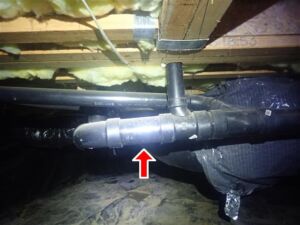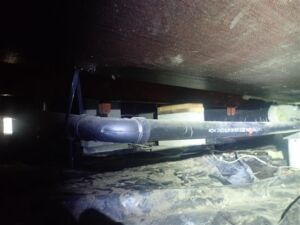
Drainage pipes are designed to flow by the force of gravity. This means that the pipes should slope downwards to the point where they reach the city or private sewer system. When pipes are level or slope away from the low point of the drain system, water, waste, and debris can accumulate. An accumulation of waste and debris will prevent proper flow within the pipes. When the flow of water and waste cannot move down, it will be forced to move up.
When enough water enters a clogged drain line it will back up into the closest plumbing fixture. This could be a sink, shower, or toilet. Not only is this a nuisance, but it can create unsanitary conditions and potential damage to the home’s building materials and an occupant’s personal items.
A sink or shower that is not draining or draining slowly, or a toilet that won’t flush properly is often the result of a clog in a drainpipe down the line. Sometimes the source of the clog is in the immediate vicinity of the plumbing fixture, such as a clogged P-trap under a sink. When a trap is accessible this should be the first location checked. P-traps are typically easy to remove and clean out. If cleaning out a trap does not fix the drainage problem, it could indicate an issue further down the pipe system.

Overflowing toilets pose a health hazard for a home’s occupants and are not fun to clean up after. Additionally, overflowing fixtures may cause water damage to the adjacent areas of a home. Water damage can be expensive to repair as the extent of the damage is often unknown until flooring or other components are removed. Water damaged materials are also more likely to develop microbial growth, such as mold.
In Oregon and Washington, plumbing codes requires drainage pipes to slope downward a minimum of ¼-inch per foot. Issues with drainpipe slopes are often the result of poor pipe installation during the initial construction of the home, or during plumbing renovations or repairs. A home’s DWV system is usually hidden within the walls, floors, basements, and crawlspaces, which makes inspection by the average homeowner difficult.
While home inspectors cannot see into concealed and finished locations throughout a home, they do enter areas that others do not. In our area homes with crawlspaces are the most common construction. During a quality home inspection, the inspector will enter a crawlspace and inspect all accessible drainpipes. The use of a level helps to ensure that the pipes are sloping in the correct direction.
Because poor drainage pipe slope is often the result of improper installation when the home is built, it is important to have an inspection performed even for new construction. Identifying defects such as this while you are still under your home’s warranty period puts the repair costs on the builder.
Improperly sloped drainpipes typically go unnoticed until a significant clog has formed. When this happens, it is an inconvenience and will require repair by a plumber. Catching this defect before a problem occurs can save a homeowner from unneeded hardship and additional expenses down the road.
